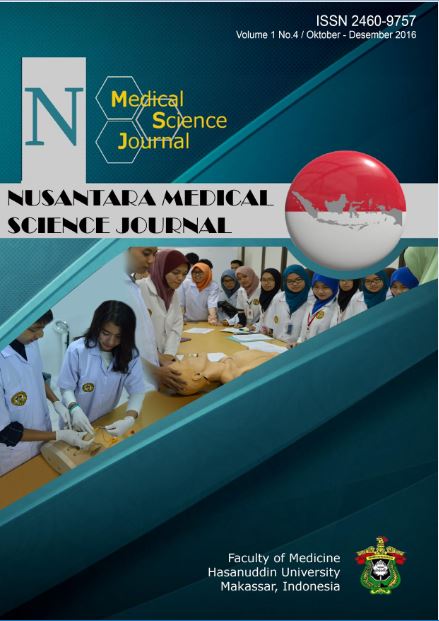THE IMPACT OF THE FREQUENCY OF 7,12- DIMETHYLBENZ [Á] ANTHRACENE (DMBA) ADMINISTRATION ON THE FORMATION OF DYSPLASIA AND SQUAMOUS CELL CARCINOMA ON THE SKIN OF ALBINO MICE
DOI:
https://doi.org/10.20956/nmsj.v1i4.2248Abstract
ABSTRACT
Introduction: Dosage and frequency of 7,12-dimethylbenz[á] anthracene (DMBA) com- pound exposure suspected to affect the rapid growth of squamous cell carcinoma (SCC) in albino mice. Objective: find out the impact of DMBA exposure to dysplasia and SCC formation on albino mice. Methods: Twenty-five albino mice were divided into five groups, namely: Group 1 is the control (acetone), group 2 is 5 albino mice given four times DMBA
100 µg exposure for eight weeks, group 3 is 5 albino mice were given eight times DMBA
100 µg exposure for eight weeks, group 4 is 5 albino mice were given twelve times DMBA
100 µg exposure for eight weeks, and group 5 is 5 albino mice were given sixteen times DMBA 100 µg exposure for eight weeks. Histopathological examination were conducted to assess histopathological feature including inflammation, dysplasia, and SCC. Results: There is a significant effect of the frequency of DMBA exposure to the clinical figure and against histopathological feature of the skin albino mice.Conclusions: Dosage and fre- quency of DMBA exposure affect the occurence of dysplasia and SCC, which are in- creasingly being DMBA exposure will accelerate the growth of SCC. The frequency of the most widely pose a SCC in DMBA 100 µg sixteen times exposure group, twice a week for eight weeks.
Keywords: DMBA, dysplasia, squamous cell carcinoma
References
Meeran SM, Vaid M, Punathil TS, Katiyar S. Dietary grape seed proanthocyanidins inhibit 12-O-tetradecanoyl phorbol-13-
acetatecaused skin tumor promotion in 7,12-dimethylbenz[a]anthracene-initiated mouse skin, which is associated with the inhibition of inflammatory responses. Carcinogenesis. 2009;30:520-8.
Dulgosz AA, Yuspa SH. Carcinogenesis: Chemical. In: Wolff K, Goldsmith LA, Katz SI, Gilchrest BA, Paller AS, Leffel DJ, editors. Fitzpatrick‘s Dermatology in General Medicine. 7th ed. New York: Mc Graw Hill.; 2008.
Rastogi S, Shukla Y, Paul BN, Chodwuri DK, Khanna SK, Das M. Protective effect of Omicum sanctum on 3-methylcholanthrene, 7,12-dimethylbenz(a)anthracene and aflatoxin B1 induced skin umorigenesis in mice. Toxic Pharmacol. 2007;224:228-40.
Yusuf N, Nasti TH, Meleth S, Elmets CA. Resveratrol enhances cell-mediated immune response to DMBA through TLR4 and prevents DMBA induced utaneous carcinogenesis. Mol Carcinog. 2009;48:713-23.
Lukitaningsih E, Noegrohati S. Studi Pemisahan senyawa hidrokarbon
poliaromatik secara kromatografi gas kolom kapiler. MFI 2000;11(1):31-8.
Sharmila R, Manoharan S. Anti-tumor activity of rosmarinic acid in 7,12-
dimethylbenz(a)anthracene (DMBA) induced skin carcinogenesis in Swiss albino mice. Indian J Exp biol. 2012;50:187-94.
Xie X, Zhang Y, Jiang Y, Liu W, Ma H, Wang Z, et al. Suppressive function of
RKTG on chemical carcinogen-induced skin carcinogenesis in mouse. Carcinogenesis. 2008;29:1632-8.
Roomi MW, Roomi NW, Kalinovsky T, Ivanov V, Rath M, Niedzwiecki A. Inhibition of 7,12-dimethylbenzanthracene-induced
skin tumors by a nutrient mixture. Med Oncol. 2008;25:333-40.
Igam N, Shukla Y. Preventive effects of diallyl sulfide on 7,12-dimethylbenz[a] anthracene induced DNA alkylation damage
in mouse skin. Mol Nutr Food Res. 2007;51:1324–8
Chun K-S, Kundu JK. Inhibition of phorbhol ester induced mouse skin tumor
promotion and COX-2 expression by celecoxib: C/EBP as a potential mpleculer target. Cancer Res Treat. 2006;38:152-8.
Kumar V, Cotran RS, Robbins SL. Neoplasma. Jakarta: EGC; 2007.
Berenblum I, Armuth V. Effect of colchicine injection prior to the initiating phase of two-stage skin carcinogenesis in mice. Br J Cancer. 1977;36:615-20









